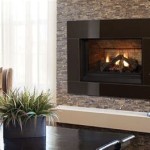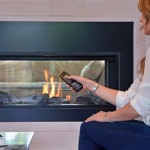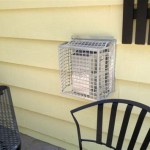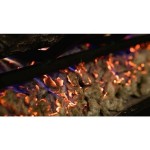Outside Wood Burning Fireplace: A Comprehensive Guide
An outside wood burning fireplace serves as a focal point for outdoor living spaces, offering warmth, ambiance, and a gathering place for social activities. The allure of flickering flames and the comforting aroma of burning wood create an inviting atmosphere, extending the usability of patios, decks, and gardens well into the cooler months. Selecting, installing, and maintaining an outside wood burning fireplace requires careful consideration of several factors, including local regulations, safety precautions, design aesthetics, and the specific needs of the property.
The functionality of an outside wood burning fireplace extends beyond mere aesthetics. Properly constructed and maintained fireplaces provide efficient heat output, allowing users to enjoy their outdoor spaces comfortably even when temperatures drop. The crackling fire creates a unique auditory experience and the visual appeal enhances the overall ambiance, making it a desirable addition to any outdoor setting. Furthermore, a well-designed fireplace can increase the property’s value and serve as a key feature for entertaining guests.
Key Considerations Before Installation
Prior to embarking on an outside wood burning fireplace project, meticulous planning is essential. This includes verifying local building codes and regulations, which often dictate specific requirements regarding clearances from structures, chimney heights, and permissible fuel types. Failure to comply with these regulations can result in fines or the need to dismantle the fireplace. Consultation with local building officials can ensure adherence to all applicable rules.
Safety represents another paramount concern. The chosen location for the fireplace should be a safe distance from combustible materials, such as fences, trees, and overhanging structures. A non-combustible base, typically concrete or stone, is crucial for providing a stable and fire-resistant foundation. The area surrounding the fireplace should be free from dry leaves and other flammable debris. A spark arrestor is a necessary component to prevent embers from escaping and potentially igniting nearby vegetation or structures. Regular inspection for structural integrity and proper function of the flue is also necessary.
Design considerations play a significant role in integrating the fireplace seamlessly into the existing outdoor space. The style of the fireplace should complement the architectural style of the house and surrounding landscape. Materials such as brick, stone, stucco, or concrete can be used to create a visually appealing and cohesive design. The size of the fireplace should be proportionate to the size of the outdoor area. Smaller spaces may benefit from a more compact design, while larger spaces can accommodate a more substantial structure. The style should also cater to the user's practical expectations, such as built-in seating or storage for firewood.
Types of Outside Wood Burning Fireplaces
Outside wood burning fireplaces are available in various configurations, each with its unique characteristics and advantages. Pre-fabricated fireplaces offer a convenient and cost-effective solution, typically consisting of modular components that are assembled on-site. These fireplaces are often made from concrete or metal and provide a consistent design and performance. Custom-built fireplaces, on the other hand, offer greater design flexibility, allowing homeowners to create a unique focal point that perfectly matches their aesthetic preferences and functional needs. These are typically constructed from stone, brick, or a combination of materials.
Chimeneas, a traditional Mexican fireplace, provide another option for outdoor heating. Chimeneas are typically made from clay or cast iron and feature a bulbous body with a tall, narrow chimney. They are relatively portable and offer a rustic charm. However, their heat output may be less than that of a traditional fireplace, and they require careful handling to prevent cracking or damage. Fire pits, while not technically fireplaces, offer a similar ambiance and warmth. Fire pits can be constructed from stone, brick, or metal and can be either wood-burning or gas-fueled. They are often a more affordable and simpler alternative to a full-scale fireplace.
The choice of fireplace type depends on budget, available space, design preferences, and heating requirements. Investigating different options and weighing their pros and cons will help determine the best solution for the specific outdoor living space.
Maintaining and Operating a Wood Burning Fireplace Safely
Proper maintenance is critical for ensuring the safe and efficient operation of an outside wood burning fireplace. Regular cleaning of the chimney is essential to remove creosote build-up, a highly flammable substance that can lead to chimney fires. The National Fire Protection Association (NFPA) recommends that chimneys be inspected and cleaned annually, or more frequently if the fireplace is used regularly.
Selecting the right type of wood is also crucial. Seasoned firewood, which has been dried for at least six months, burns more efficiently and produces less smoke than green wood. Hardwoods, such as oak, maple, and ash, provide a longer, hotter burn than softwoods, such as pine and fir. Avoid burning treated wood, painted wood, or construction debris, as these materials can release harmful chemicals into the air.
Operating the fireplace safely requires vigilance and adherence to basic fire safety principles. Never leave a fire unattended. Keep a fire extinguisher, a bucket of water, or a garden hose nearby in case of emergencies. Supervise children and pets closely when the fireplace is in use. Ensure that the fire is completely extinguished before leaving the area. Dispose of ashes properly in a metal container with a tight-fitting lid, and avoid placing the container near combustible materials. Following these guidelines can significantly reduce the risk of accidents and ensure a safe and enjoyable outdoor fire experience.
Building a fire safely involves layering tinder, kindling, and firewood. Tinder, such as dry leaves or paper, readily ignites and serves as the initial fuel source. Kindling, small twigs and branches, helps to build the fire gradually. Firewood, larger logs, sustains the fire for an extended period. Arranging the firewood in a teepee or log cabin configuration allows for proper airflow and efficient combustion. Avoid overcrowding the firebox, as this can limit oxygen supply and produce excessive smoke.

Outdoor Fireplaces Charlotte Fireplace Design Coogans Build

42 Castlewood Outdoor Wood Burning Fireplace Fine S Gas

Outdoor Wood Burning Fireplace

Outdoor Fireplace Kits Stonewood S Cape Cod Ma Nh Ct

Outdoor Fireplace Builder Richmond Va Dreams

Outdoor Wood Burner Stove Asgard

Outdoor Wood Fireplaces Jetmaster

Outdoor Wood Burning Fireplace With Chimney Gardenesque

Outdoor Wood Burning Fireplaces Ideas On Foter Fireplace Stove

Suoy Curtis 56 69 In Wood Burning Outdoor Fireplace With Broe Highlights 169476 The Home Depot
Related Posts








